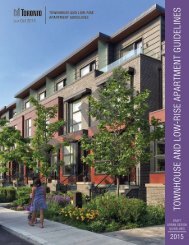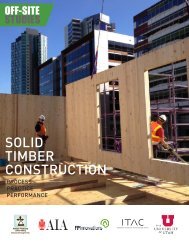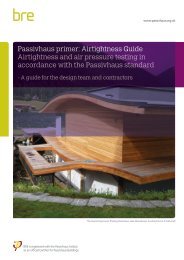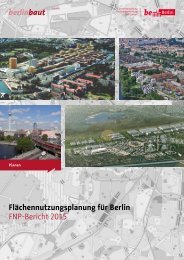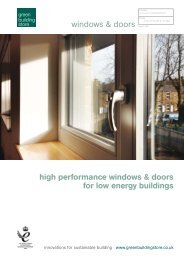TRUE URBAN SPIRIT
b008379b
b008379b
You also want an ePaper? Increase the reach of your titles
YUMPU automatically turns print PDFs into web optimized ePapers that Google loves.
GLOSSARY<br />
tive Group for Construction and Technology.<br />
Its task lies in developing a basis for<br />
political decision-making regarding the<br />
installation of technical and social infrastructure<br />
in connection with urban development<br />
projects.<br />
Intermodality<br />
Intermodality is the use of several means<br />
of conveyance for the transport of persons<br />
or goods when involving trip chains.<br />
One example might be the use of a car<br />
or bicycle to reach a train station in order<br />
to continue a journey from there. In goods<br />
transport, intermodality embodies the<br />
transport of standardised units (e. g. containers)<br />
and their shipping via different<br />
means of transport, e. g. rail and lorry.<br />
Knowledge economy<br />
The term “knowledge economy” defines<br />
those economic activities that are particularly<br />
dependent on a knowledge base,<br />
from which they develop new knowledge<br />
or innovative high-tech products in turn.<br />
The knowledge economy is composed<br />
of three interlinked pillars – universities,<br />
high-tech production and knowledgeintensive<br />
services. The importance of<br />
knowl edge-oriented economic activities is<br />
growing, which makes them a key driver<br />
of the economic and spatial development<br />
of metropolitan regions.<br />
KÖR GmbH – Kunst<br />
im öffentlichen Raum<br />
In 2004, the establishment of the Fund<br />
for Art in Public Space set the course for<br />
high-quality artistic design of public space.<br />
Since then, KÖR, which today is organised<br />
as a public limited liability company, has<br />
evolved into an interdepartmental model<br />
instrument involving the Administrative<br />
Groups for Housing, Housing Construction<br />
and Urban Renewal and for Cultural<br />
Affairs and Science. Over the past decade,<br />
KÖR GmbH has implemented around<br />
140 projects in Vienna’s public space.<br />
Landscape account<br />
A selection of priority areas is proposed<br />
by the City of Vienna and the Federal<br />
Province of Lower Austria as a basic<br />
structure for compensation measures in<br />
environmental impact assessments.<br />
Areas from this landscape account can<br />
then be immediately used for non-sitespecific<br />
compensation and balancing<br />
measures. Controlling, evaluation and<br />
further development are carried out<br />
by the competent municipal departments<br />
and their designated experts.<br />
Land use category “Housing construction<br />
eligible for subsidisation”<br />
In areas thus classified, it is permitted to<br />
erect only buildings that meet certain<br />
structural specifications based on the<br />
housing subsidy system, e. g. thermal<br />
insulation or maximum useful floorspace<br />
per housing unit. This is to ensure that a<br />
sufficient volume of affordable dwellings<br />
can be constructed in the future as well.<br />
Master Plan for a Viennese Urbanity<br />
Campaign<br />
The Vienna Economic Chamber has de -<br />
veloped a catalogue of measures to<br />
preserve ground-floor zones. The catalogue<br />
contains proposals for upgrading<br />
ground-floor zones and is to provide<br />
suggestions for preserving the diversity<br />
of Vienna’s small- and medium-scale economy,<br />
which is considered a major contributor<br />
to urban appeal.<br />
Metropolitan region<br />
A metropolitan region is an area comprising<br />
at least one big city of international<br />
importance, serving a variety of high-level<br />
centralised functions, and the region<br />
surrounding it. As a rule, such a region<br />
encompasses, in addition to the urban<br />
agglomeration, further core settlements<br />
as well as rural zones that are closely<br />
linked to the regional centre, e. g. by commuter<br />
traffic flows. As central nuclei of<br />
co-operation and competition, metropolitan<br />
regions are hubs of international<br />
networking. Metropolitan regions may<br />
have up to 20 million inhabitants, may be<br />
transboundary, are politically defined in<br />
a variety of ways and usually lack institutions<br />
of their own.<br />
Mission Statement “Social Work in<br />
(Semi-) Public Space”<br />
The Mission Statement “Social Work<br />
in (Semi-) Public Space” expresses the<br />
stance of the City of Vienna regarding<br />
social work in public and semi-public<br />
space. Vienna thus defines itself as a<br />
pluralistic metropolis that is characterised<br />
by internationality and diversity and<br />
pursues a policy of tolerance, integration,<br />
inclusion and prevention. The tasks of<br />
social work comprise the targeted promotion<br />
of community and educational work,<br />
social cohesion as well as the strengthening<br />
of personal responsibility and the<br />
ability for self-organisation on the part of<br />
the actors involved.<br />
Modal split<br />
Distribution of traffic volumes across<br />
several means of transport (modes). As<br />
a rule, the modal split refers to trips<br />
and indicates which means of transport<br />
are used for a certain percentage of trips.<br />
Multimodality<br />
In simple words, multimodality applies<br />
if more than one means of transport is or<br />
can be used to cover a distance or to<br />
transport goods; for travelling from and<br />
to work, a person may e. g. use either a<br />
bicycle or a car, or merchandise may<br />
be brought to its destination by a combination<br />
of navigation and railway.<br />
Multiple use<br />
Multiple use of available open spaces in<br />
the city is a reaction to the scarcity of<br />
urban open spaces as well as to current<br />
and local demands and moreover complements<br />
existing open space programmes.<br />
It is the main objective of multiple<br />
use to open potentials of municipally<br />
owned plots to other interested parties,<br />
e. g. the use of schoolyards and school<br />
sports grounds in the afternoon, during<br />
weekends or in the holidays.<br />
NFSR − net floorspace ratio<br />
The floorspace ratio (FSR) embodies the<br />
ratio of a building's total floor area to the<br />
size of the piece of land upon which it is<br />
138



